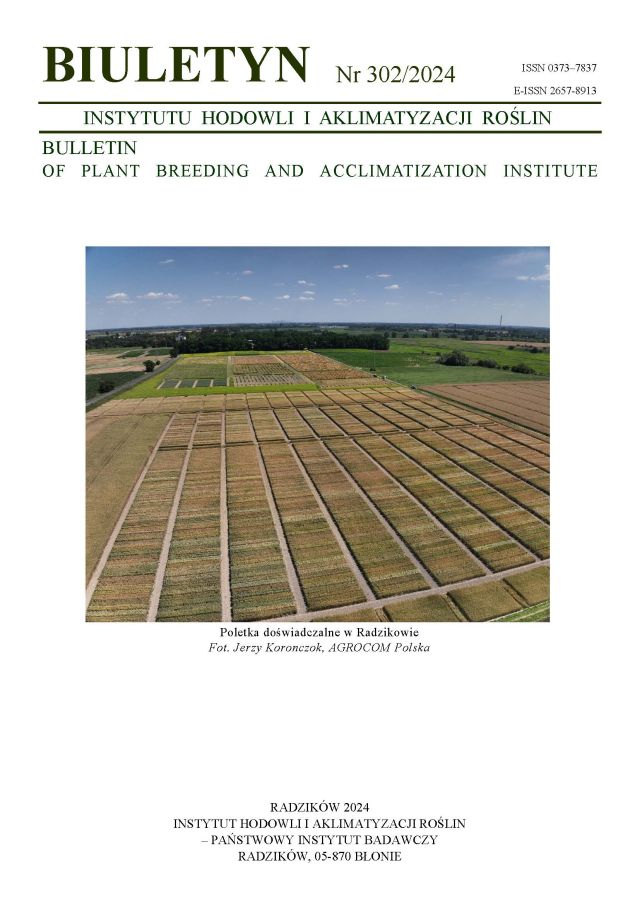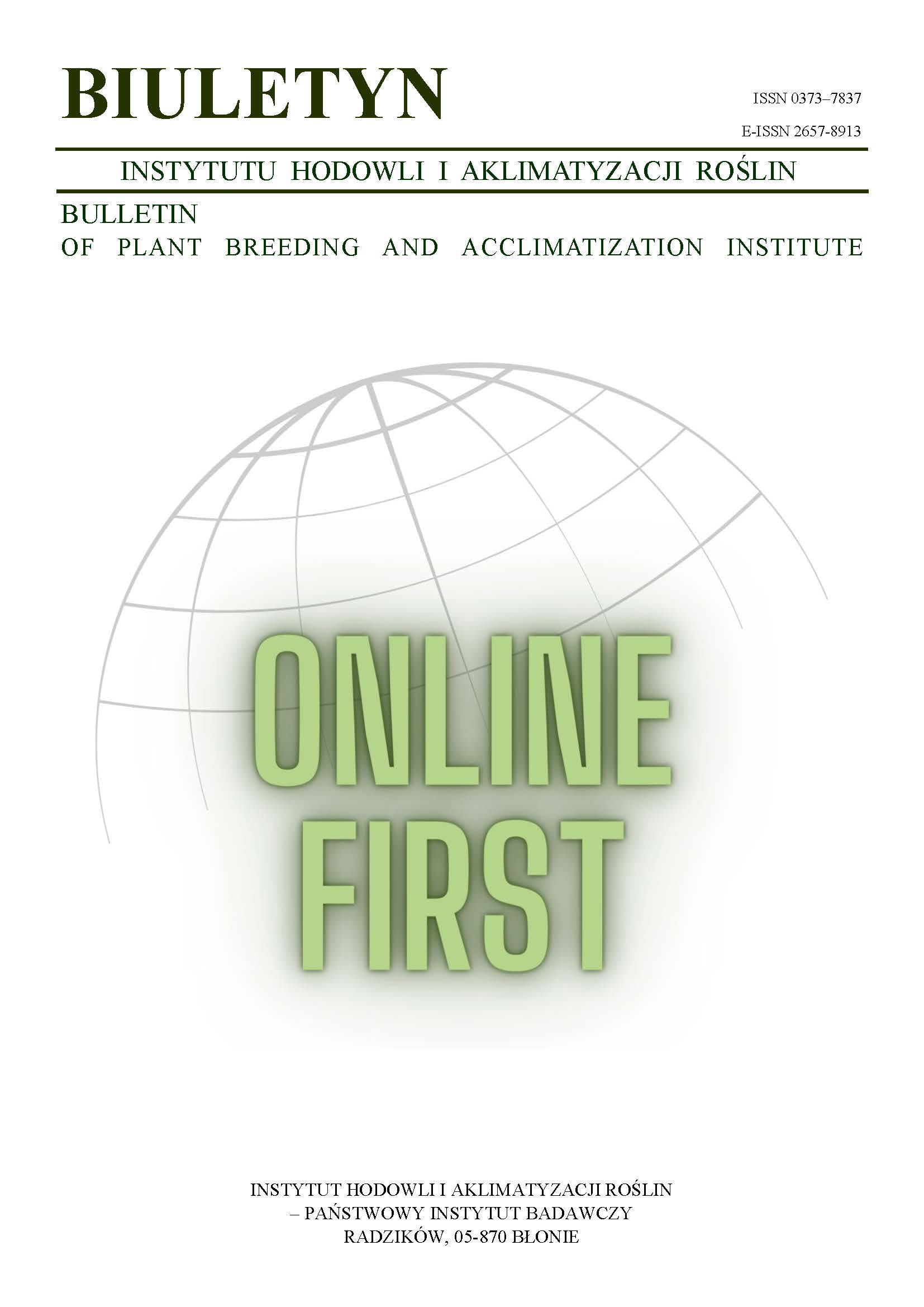Przenoszenie różnych genetycznie izolatów wirusa Y ziemniaka przez mszyce i podatność chwastów na infekcję wirusem
Agnieszka Kaliciak
a.kaliciak@ihar.edu.plInstytut Hodowli i Aklimatyzacji Roślin, Oddział Młochów (Poland)
Jerzy Syller
Instytut Hodowli i Aklimatyzacji Roślin, Oddział Młochów (Poland)
Abstrakt
Wirus Y ziemniaka (PVY) jest ważnym gospodarczo patogenem atakującym uprawy ziemniaka, tytoniu i papryki. Wirus przenoszony jest w sposób nietrwały przez mszyce, głównie przez Myzus persicae. Do efektywnego przeniesienia wirusa z rośliny chorej na zdrową wystarcza krótki (< 1 min.) czas żerowania owada na roślinie. Od ponad 20 lat stwierdza się szybkie rozprzestrzenianie nowych, bardziej infekcyjnych wariantów PVY, najczęściej klasyfikowanych w podgrupach PVYNTN i PVYNW szczepu PVYN. Dynamiczne szerzenie się nowych wariantów genetycznych PVY może wskazywać, że efektywnie współdziałają one z wektorami wirusa. W prowadzonych w Młochowie badaniach nad przenoszeniem przez M. persicae 12 izolatów PVY na rośliny Nicotiana tabacum, Physalis floridana i Solanum nigrum zastosowano krótki i długi czas żeru nabycia wirusa na roślinach stanowiących źródła wirusa. Wykazano, że izolaty PVYNTN i PVYNW były przenoszone istotnie efektywniej, niż znane od dawna, standardowe izolaty PVYN i PVY0. Stwierdzono ponadto, że mszyce nadspodziewanie efektywnie przenosiły niektóre izolaty po długotrwałym (3 dni) żerowaniu na roślinach źródłowych. Stopień porażenia inokulowanych roślin zależał także od ich gatunku. Zróżnicowanie genetyczne w obrębie populacji PVY nie może pozostawać bez wpływu na zdolność współdziałania wirusa z roślinami-gospodarzami, a w konsekwencji na zakres gospodarzy wirusa. Gospodarzami PVY, oprócz roślin uprawnych, są niektóre gatunki roślin dziko żyjących. Porażone chwasty mogą pełnić rolę naturalnego rezerwuaru wirusa i stanowić źródło infekcji pierwotnej. Zidentyfikowano trzech nowych, naturalnych gospodarzy PVY wśród chwastów powszechnie występujących w Polsce. Są to: bodziszek drobny i iglica pospolita (Bodziszkowate) oraz jasnota purpurowa (Jasnotowate). Potwierdzono ponadto wcześniejsze doniesienie z Grecji, że gospodarzem PVY jest sałata kompasowa (Astrowate), chwast popularny również w warunkach naszego kraju.
Instytucje finansujące
Słowa kluczowe:
chwasty, ELISA, efektywność przenoszenia, IC-RT-PCR, izolaty, Myzus persicae, PVYBibliografia
Alvarez J. M., Srinivasan R., Cervantes F., Eigenbrode S., Bosque-Perez N., Hutchinson P., Pantoja A. 2007. Importance of alternative plant hosts in the epidemiology of PLRV and PVY. Abstracts from the 13th EAPR Virology Section Meeting, Scotland, 18–21 June, 42.
Google Scholar
Beczner L., Horváth J., Romhányi I., Förster H. 1984. Studies on the etiology of tuber necrotic ringspot disease in potato. Potato Res. 27: 339 — 352.
Google Scholar
Bradley R. H. E. 1954. Studies on the mechanism of transmission of potato virus Y by the green peach aphid, Myzus persicae (Sulz.) (Homoptera: Aphididae). Can. J. Entomol. 32: 64 — 73.
Google Scholar
Brunt A. A., Crabtree K., Dallwitz M. J., Gibbs A. J., Watson L., Zurcher E. J. 1996. 20 August. Plant Viruses Online: Descriptions and Lists from the VIDE Database. Retrieved from http://image.fs.uidaho.edu/vide/refs.htm
Google Scholar
Chatzivassiliou E.K., Efthimiou K., Drossos E., Papadopoulou A., Poimenidis G., Katis N. I. 2004. A survey of tobacco viruses in tobacco crops and native flora in Greece. Eur. J. Plant Pathol. 110: 1011 — 1023.
Google Scholar
Chrzanowska M. 1991. New isolates of the necrotic strain of potato virus Y (PVYN) found recently in Poland. Potato Res. 34: 179 — 182.
Google Scholar
Chrzanowska M. 1994. Differentiation of potato virus Y (PVY) isolates. Phytopath. Polonica 8: 15 — 20.
Google Scholar
Chrzanowska M., Doroszewska T., Zagórska H. 2002. Zróżnicowanie izolatów wirusa Y ziemniaka w zależności od kryterium oceny. Acta Agrobot. 55: 59 — 67.
Google Scholar
Dedic P., Ptacek J., Cerovska N. 2007. A shift of PVY strain spectrum on potatoes in CR in the course of past years. Abstracts from the 13th EAPR Virology Section Meeting, Scotland, 18 — 21 June, 59.
Google Scholar
Edwardson J. R., Christie R. G. 1997. Viruses infecting peppers and other Solanaceous crops. (Monograph 18 — I and II). FL: University of Florida Press, Gainesville.
Google Scholar
Fletcher J. D. 2001. New hosts of Alfalfa mosaic virus, Cucumber mosaic virus, Potato virus Y, Soybean dwarf virus, and Tomato spotted wilt virus in New Zealand. New Zealand J. Crop Hortic. Sci. 29: 213 — 217.
Google Scholar
Glais L., Tribodet M., Kerlan C. 2002. Genomic variability in Potato potyvirus Y (PVY): evidence that PVYNW and PVYNTN variants are single to multiple recombinants between PVYO and PVYN isolates. Arch. Virol. 147: 363 — 378.
Google Scholar
Glais L., Colombel A.S., Tribodet M., Kerlan C. 2004. PVYN 605, the reference PVYN isolate, displays a PVYNTN non-recombinant genome. Abstracts from the 12th EAPR Virology Section Meeting, Rennes, France, 13-19 June, 50.
Google Scholar
Kanavaki O. M., Margaritopoulos J. T., Katis N.I., Skouras P., Tsitsipis J. A. 2006. Transmission of potato virus Y in tobacco plants by Myzus persicae nicotianae and M. persicae. Plant Dis. 90: 777 — 782.
Google Scholar
Kazinczi G., Horvath J., Takacs A.P., Gaborjanyi R., Beres I. 2004. Experimental and natural weed host-virus relations. Commun. Agric. Appl. Biol. Sci. 69: 53 — 60.
Google Scholar
Kerlan C., Tribodet M., Glais L., Guillet M. 1999. Variability of potato virus Y in potato crops in France. J. Phytopathol. 147: 643 — 651.
Google Scholar
Kerlan C. 2006. October. Potato virus Y. Descriptions of Plant Viruses, no. 414. Retrieved from http://www.dpvweb.net/dpv/showdpv.php?dpvno=414
Google Scholar
Le Romancer M., Kerlan C., Nedellec M. 1994. Biological characterization of various geographical isolates of potato virus Y inducing superficial necrosis on potato tubers. Plant Pathol. 43: 138 — 144.
Google Scholar
Lindner K. 2007. PVY strains in Germany — the period between 1984 and 2006. Abstracts from the 13th EAPR Virology Section Meeting, Scotland, 18–21 June, 65.
Google Scholar
McDonald J. G., Singh R.P. 1996. Host range, symptomology and serology of isolates of potato virus Y (PVY) that share properties with both the PVYN and PVY0 strain groups. Am. Potato J. 73: 309 — 315.
Google Scholar
Ng J. C. K., Falk B. W. 2006. Virus-vector interactions mediating nonpersistent and semipersistent transmission of plant viruses. Annu. Rev. Phytopathol. 44: 183 — 212.
Google Scholar
Nie X., Singh R. P. 2001. Possible evolution of tuber ringspot necrosis strains (PVYNTN) from the regional tobacco veinal necrosis (PVYN) strains. Abstracts from the 11th EAPR Virology Section Meeting, Havličkův Brod-Trest, Czech Republic: 4 — 6.
Google Scholar
Radcliffe E. B., Ragsdale D. W. 2002. Aphid-transmitted potato viruses: the importance of understanding vector biology. Amer. J. Potato Res. 79: 353 — 386.
Google Scholar
Rouze-Jouan J., Glais L., Crocq G., Gauthier J. P., Kerlan C. 2004. Study of aphid transmissibility of a set of isolates of Potato virus Y strain PVYC. Abstracts from the 12th EAPR Virology Section Meeting, Rennes, France, 13–19 June, 22.
Google Scholar
Schubert J., Fomitcheva V., Sztangret-Wiśniewska J. 2007. Differentiation of Potato virus Y strains using improved sets of diagnostic PCR-primers. J. Virol. Methods, 140: 66 — 74.
Google Scholar
Shukla D. D., Ward C.W., Brunt A. A. 1994. The Potyviridae. Cambridge University Press, Cambridge.
Google Scholar
Sigvald R. 1984. The relative efficiency of some aphid species as vectors of potato virus Y. Potato Res. 27: 285 — 290.
Google Scholar
Souza-Dias J. A. C de., Sawazaki H. E., Miranda Filho H. S. 2007. PVYNTN in Brazil: Occurrence, impact and characterization. Abstracts from the 13th EAPR Virology Section Meeting, Scotland, 18–21 June, 32.
Google Scholar
Weidemann H. L., Maiss E. 1996. Detection of the potato tuber necrotic ringspot strain of potato virus Y (PVYNTN) by reverse transcription and immunocapture polymerase chain reaction. J. Plant Dis. Prot., 103: 337 — 345.
Google Scholar
Xu H. 2007. Status of potato viruses in Canada. Abstracts from the 13th EAPR Virology Section Meeting, Scotland, 18–21 June: 74.
Google Scholar
Zitter T. A. 2001. Vegetable MD Online. Vegetable Crops: A checklist of major weeds and crops as natural hosts for plant viruses in the Northeast. Version: November. 2001. http://vegetablemdonline.ppath.cornell.edu/Tables/WeedHostTable.html.
Google Scholar
Autorzy
Agnieszka Kaliciaka.kaliciak@ihar.edu.pl
Instytut Hodowli i Aklimatyzacji Roślin, Oddział Młochów Poland
Autorzy
Jerzy SyllerInstytut Hodowli i Aklimatyzacji Roślin, Oddział Młochów Poland
Statystyki
Abstract views: 172PDF downloads: 97
Licencja
Prawa autorskie (c) 2009 Agnieszka Kaliciak, Jerzy Syller

Utwór dostępny jest na licencji Creative Commons Uznanie autorstwa – Na tych samych warunkach 4.0 Miedzynarodowe.
Z chwilą przekazania artykułu, Autorzy udzielają Wydawcy niewyłącznej i nieodpłatnej licencji na korzystanie z artykułu przez czas nieokreślony na terytorium całego świata na następujących polach eksploatacji:
- Wytwarzanie i zwielokrotnianie określoną techniką egzemplarzy artykułu, w tym techniką drukarską oraz techniką cyfrową.
- Wprowadzanie do obrotu, użyczenie lub najem oryginału albo egzemplarzy artykułu.
- Publiczne wykonanie, wystawienie, wyświetlenie, odtworzenie oraz nadawanie i reemitowanie, a także publiczne udostępnianie artykułu w taki sposób, aby każdy mógł mieć do niego dostęp w miejscu i w czasie przez siebie wybranym.
- Włączenie artykułu w skład utworu zbiorowego.
- Wprowadzanie artykułu w postaci elektronicznej na platformy elektroniczne lub inne wprowadzanie artykułu w postaci elektronicznej do Internetu, lub innej sieci.
- Rozpowszechnianie artykułu w postaci elektronicznej w internecie lub innej sieci, w pracy zbiorowej jak również samodzielnie.
- Udostępnianie artykułu w wersji elektronicznej w taki sposób, by każdy mógł mieć do niego dostęp w miejscu i czasie przez siebie wybranym, w szczególności za pośrednictwem Internetu.
Autorzy poprzez przesłanie wniosku o publikację:
- Wyrażają zgodę na publikację artykułu w czasopiśmie,
- Wyrażają zgodę na nadanie publikacji DOI (Digital Object Identifier),
- Zobowiązują się do przestrzegania kodeksu etycznego wydawnictwa zgodnego z wytycznymi Komitetu do spraw Etyki Publikacyjnej COPE (ang. Committee on Publication Ethics), (http://ihar.edu.pl/biblioteka_i_wydawnictwa.php),
- Wyrażają zgodę na udostępniane artykułu w formie elektronicznej na mocy licencji CC BY-SA 4.0, w otwartym dostępie (open access),
- Wyrażają zgodę na wysyłanie metadanych artykułu do komercyjnych i niekomercyjnych baz danych indeksujących czasopisma.














